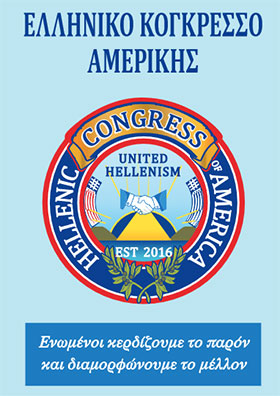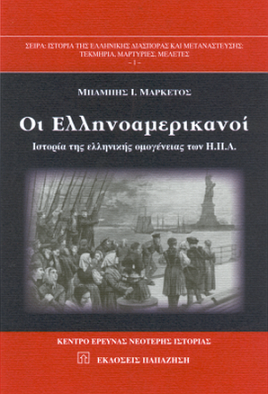Things Greek and Greek American are a Universal Heritage

Bethany Fleming, Curator of the National Hellenic Museum and of the Museum’s current exhibitions, talked about the exhibitions currently at the Museum, the universal relevance of its exhibitions, and what to consider when contemplating making donations to the Museum. She also provides an interesting analysis of how it is to work on Greek American topics when one is not of Greek heritage.

Bethany Fleming (right) with board member Stephanie Vlahakis.
Concurring with Mr. Calamos and Ms. Mourtoupalas’s premise that Greek American history is American history, Ms. Fleming said, “It’s exciting that the exhibition ‘American Moments: The Legacy of Greek Immigration’, tells a number of stories of significant episodes in American history, such as the Labor Movement, Civil Rights, Abolition, and the Civil War,” said Fleming, “all of which included significant Greek American contributions. In telling these stories, we worked with large institutions such as the New York Public Library, and small organizations such as the Lowell (Massachusetts) Hellenic Heritage Association to bring together an incredible, diverse collection of photographs that help fill out the national and universal scope of the story. And within our own collection we have many items from all over the country, including many from the New York area.”
“We hope all visitors can connect with the ‘American Moments: The Legacy of Greek Immigration’. We bookend the exhibit with push & pull factors for immigration, in the late 1800s, and today. In the introduction we mention the headlines from 100 years ago, when Greece declared bankruptcy after Europe’s Long Depression, and we conclude with current headlines exploring the possibility of increased Greek emigration because of the current economic climate. The story is cyclical, and while we focus on the Greek perspective, we want visitors to take away the fact that this story is a significant, ongoing factor in our evolving American story.”
“It has been very rewarding putting together ‘American Moments: The Legacy of Greek Immigration’”, said Fleming, “The exhibition features photographs from around the country, many from our own collections, and a large amount from large and small institutions all over the United States as well as highlighting artifacts from our collection. These photographs and artifacts come together to tell a compelling story of not only Greek American history, but of American history in general, and the elements that have come together to make our American society what it is today.”
Ms. Fleming tells the public that because part of the National Hellenic Museum’s mission is to safeguard and preserve Greek and Greek American history, “We are always actively looking to add to our collection and hope people will consider donating their family items to the museum… Part of the National Hellenic Museum’s mission is to safeguard and preserve Greek and Greek American history.”
Asked what donations are accepted by the Museum, Fleming answered that generally speaking, any items that help to further that mission are accepted. “The main focus of the Museum’s collection is Greek American immigration; however, we do specialize in other areas as well, such as ancient and classical Greece, the Byzantine era, and modern Greece. Types of items we accept into our collection include, but are not limited to, textiles, machinery, furniture, jewelry, photographs, records, business materials, utensils, tools, signage, appliances, clothing, awards, books, publications, personal archives, and hundreds of other types of items.”
What should be considered when one is considering donating artifacts or archival materials to the Museum? “One of the things we encourage people to consider when donating to the museum is the story that can be told through their family’s photographs and artifacts,” said Fleming, “Stories become much richer and are more easily conveyed in meaningful ways if we are able to include multiple facets of that story. For example, if someone is donating a dress that their grandmother brought over when she immigrated to the United States, we would be very interested in also including photographs of their grandmother, immigration documents, and any other personal items that relate to her immigration experience. By donating all of these corresponding pieces, we are then able to interpret a much fuller story.”
As the GN is a New York-based publication, Ms. Fleming described the donation of the Barbatsuly family of New York (some of which is included in the present exhibition) providing an example of what a collection might contain: “The Barbatsuly donation is a tremendous collection of objects, documents, and photographs from the Barbatsuly family of Plattekill, NY. The family immigrated to New York in the early 1900s, before and after the Balkan Wars. They were furriers from Kastoria, and began their own businesses in New York City. The collection, which was donated before a few members of the family moved out of the city to a farm in Plattekill, NY, includes immigration and naturalization documents such as passports and certificates, and family records. The photographs include general family photos, as well family members involved in groups such as AHEPA. Objects include family items such as the jug and shot glasses used with their homemade ouzo, and many personal items brought to America from Greece including komboloi beads, a handheld mirror from Turkey, Turkish coins made into a bracelet, a Turkish seal, and a “poison” ring. The last few items speak to the fact that the family lived in the northern part of Greece still under Ottoman occupation around the time of their immigration. Many of the women in the family carried poison rings in case of capture by the Ottomans.”
ΠΗΓΗ: greeknewsonline.com










Σχόλια Facebook